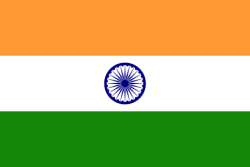Republic of India
Related Categories:
 India - Fotw
India - FotwNational Flag and Jack, Colours of the flag, Meaning of the flag, Flag Code, Detail of the Chakra.
www.fotw.us/
Home to the Indus Valley civilization and a region of historic trade routes and vast empires, the Indian subcontinent was identified with its commercial and cultural wealth for much of its long history.
en.wikipedia.org/
Although India occupies only 2.4% of the world's land area, it supports over 15% of the world's population. Only China has a larger population. Almost 33% of Indians are younger than 15 years of age. About 70% live in more than 550,000 villages, and the remainder in more than 200 towns and cities. Over the thousands of years of its history, India has been invaded from the Iranian plateau, Central Asia, Arabia, Afghanistan, and the West; Indian people and culture have absorbed and modified these influences to produce a remarkable racial and cultural synthesis.
Religion, caste, and language are major determinants of social and political organization in India today. The government has recognized 18 official languages; Hindi, the national language, is the most widely spoken, although English is a national lingua franca. Although 82% of its people are Hindu, India also is the home of more than 138 million Muslims--one of the world's largest Muslim populations. The population also includes Christians, Sikhs, Jains, Buddhists, and Parsis.
The Hindu caste system reflects Indian occupational and socially defined hierarchies. Ancient Sanskrit sources divide society into four major categories, priests (Brahmin), warriors (Kshatriya), traders (Vaishya) and farmers/laborers (Shudra). Although these categories are understood throughout India, they describe reality only in the most general terms. They omit, for example, the tribes and those once known as "untouchables." In reality, Indian society is divided into thousands of jatis--local, endogamous groups based on occupation--and organized hierarchically according to complex ideas of purity and pollution. Despite economic modernization and laws countering discrimination against the lower end of the caste structure and outlawing "untouchability," the caste system remains an important source of social identification and a potent factor in the political life of the country. Nevertheless, the government has made strong efforts to minimize the importance of caste through active affirmative action and social policies. Moreover, caste has been diluted if not subsumed in the economically prosperous and heterogeneous cities, where an increasing percentage of India's population lives. In the countryside, expanding education, land reform and economic opportunity through access to information, communication, transport, and credit have lessened the harshest elements of the caste system.
www.state.gov/r/
Introduction
About
Contact
Symbols in The News
Interpret this Symbol
AAC
African
AI
Alchemy
Alphabets
Ancient
Animal Symbolism
Architecture
Art
Articles
Astrology
Baha'i
Blissymbolics
Blueprint Symbols
Buddhist
Celtic Symbols
Cemetery
Chinese Symbols
Christian
Circle
City
Codes
Color
Conlangs
Crop Circles
Danger
Da Vinci Code
Designing Logos
Dictionaries
Dreams
Education
Egyptian Symbols
Electrical
Emoticons
Find Images
Fonts
Food
Fraternity
Hamsa
Healing
Heraldry
Hermetic
Highway Signs
Hindu
History
Hobo
Holiday
Icons
iConji
Islamic
Jain Symbols
Japanese, Kanji
Jewish
Justice
Law
Literary Symbolism
Mandalas
Map
Masonic
Math, Number
Meaning of Names
Medical
Middle East
Military
Miscellaneous
Money
Music
Mythology
Native American
Playing Cards
Power
Psychology
QiQiiKhu
Reiki
Religious
Runes, Norse
Sacred Geometry
Scientific
Science Fiction
Sorority
Sports
Symbols in the News
Tattoos
ThirteenSymbols
Tree of Life
Ursprache
Videos
Visual Languages
Weather
Web Codes
Wicca
Words
Writing Systems
Braille
Coinherence
Coptic
Cuneiform
Easter Island
Etruscan
Happy Human
Hebrew
Kokopelli
Linear B
Lotus
Love Symbols
Mandorla
Moon Alphabet
Nine Pointed Star
Om
Oz
Phonetic
Scarab Beetle
Silent
Theosophy
Unifon
About
Contact
Symbols in The News
Interpret this Symbol
AAC
African
AI
Alchemy
Alphabets
Ancient
Animal Symbolism
Architecture
Art
Articles
Astrology
Baha'i
Blissymbolics
Blueprint Symbols
Buddhist
Celtic Symbols
Cemetery
Chinese Symbols
Christian
Circle
City
Codes
Color
Conlangs
Crop Circles
Danger
Da Vinci Code
Designing Logos
Dictionaries
Dreams
Education
Egyptian Symbols
Electrical
Emoticons
Find Images
Fonts
Food
Fraternity
Hamsa
Healing
Heraldry
Hermetic
Highway Signs
Hindu
History
Hobo
Holiday
Icons
iConji
Islamic
Jain Symbols
Japanese, Kanji
Jewish
Justice
Law
Literary Symbolism
Mandalas
Map
Masonic
Math, Number
Meaning of Names
Medical
Middle East
Military
Miscellaneous
Money
Music
Mythology
Native American
Playing Cards
Power
Psychology
QiQiiKhu
Reiki
Religious
Runes, Norse
Sacred Geometry
Scientific
Science Fiction
Sorority
Sports
Symbols in the News
Tattoos
ThirteenSymbols
Tree of Life
Ursprache
Videos
Visual Languages
Weather
Web Codes
Wicca
Words
Writing Systems
Braille
Coinherence
Coptic
Cuneiform
Easter Island
Etruscan
Happy Human
Hebrew
Kokopelli
Linear B
Lotus
Love Symbols
Mandorla
Moon Alphabet
Nine Pointed Star
Om
Oz
Phonetic
Scarab Beetle
Silent
Theosophy
Unifon

